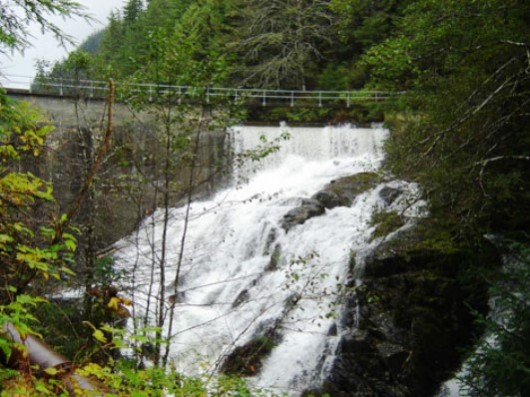Ketchikan’s newest source of hydroelectric power at Whitman Lake is at least a few weeks away from completion. While most of the work is done, both generators have issues that need to be resolved before Whitman can start adding its 4.6 megawatts to the city-owned Ketchikan Public Utilities electric grid.
The Whitman Lake hydroelectric project has cost upwards of $30 million over 15 years. Some of that was paid for through grants from the Alaska Energy Authority and the Ketchikan Gateway Borough. But the biggest chunk — $14 million — was paid for through bonds approved by City of Ketchikan voters.
“And then the fun thing is, we spent it all. So we’re at the end,” said KPU Electric Division Manager Andy Donato, who described the project as “incredible.”
Three major contractors worked on it: Dawson Construction, S&S Construction and Burke, a Washington firm that helped find the equipment. Most of that was manufactured in China, including the generators.
Whitman has two units, a large one that will only run when there’s a lot of water in the lake; and a smaller one that’s designed to run constantly.
“Because it’s a bear observatory area, there’s a lot of touring vans that come in, especially when the salmon are in and the bears are feeding,” Donato said. “So, I appropriately call the large unit Yogi and the small unit BooBoo. “
Yogi and BooBoo have had some issues during testing. When they turned the large unit on, there was a nut that had been left in the pipe. Donato said that nut was about the size of a coffee cup. It was flushed through the pipe, and made it through the wicket gates, “and then it banged and ricocheted off the runner as it was spinning, much like a pinball machine, and then it managed to break apart in pieces, so you can imagine the forces to take an inch-and-a-half nut and break it into five pieces, peened it smooth like river rock and caused some minor internal damage.”
And by that, Donato means dents. “Lots of dents. Like, lots and lots of dents.”
Donato said the city worked through that issue with the manufacturer and the contractors. While the unit does function, KPU isn’t going to accept it in its damaged condition. So, the manufacturer will send some replacement parts.
Now, on to the smaller unit, which has sonic and vibration issues.
“The sonic anomaly, I suppose you could wear hearing protection and tolerate that. It’s loud,” he said. “But along with the sonic anomaly is vibration. So, all the instruments around it vibrate. That will shorten their lives; that will fatigue the metal.”
Donato said they believe the cause of both the noise and vibration to be something similar to a cruise ship’s bow wake.
“As the propeller blades, if you will, from the turbine cut through the water, it produces the same wake. And that wake is called the Karmen vortex street,” he said.
And within that wake is a lot of small eddies, like mini tornadoes, that create a resonance, “and they’ve got that mapped out so they know somewhat the cause. They just haven’t quite figured out possible solutions.”
Donato expects that to be resolved in a few weeks.
Once it’s operating the Whitman project will provide the equivalent of 9 percent of Ketchikan’s power use in an average year. That could mean KPU wouldn’t need to use backup diesel generators as much, but then again, “timing is everything. Chances are, if we run out of water in the lakes or run low on water, we’ll most likely be running low on water in Whitman,” Donato said. “But, if we can, it would be nice in certain outages to kick on the large machine at Whitman if there’s significant water, and use its 3.9 megawatts for support as opposed to running diesel. So it will make an impact, long-term.”
The larger unit sucks a lot of water out of Whitman, which is not a large lake. So it can only be used after a big rainstorm. The smaller unit, though, is designed to run constantly, and provides 0.7 megawatts.
Ketchikan has an agreement with the Southeast Alaska Power Agency for how it can use Whitman’s power. A previous agreement requires KPU to buy power from SEAPA before it uses power from a new project, such as Whitman.
If SEAPA can’t provide power because of maintenance or outages, KPU can use Whitman power at no extra charge.
“On days when SEAPA can supply our firm power requirement, and we elect to run Whitman, then we owe SEAPA a true-up,” Donato said.
The Ketchikan City Council approved that true-up agreement in August, and the agreement passed SEAPA’s board in mid-September.
During the City Council discussion of that issue, Council Member Bob Sivertsen, who also chairs the SEAPA board, said Ketchikan would sell Whitman’s power to ratepayers for 9.5 cents per kilowatt hour, but then pay SEAPA 6.8 cents per kilowatt hour for the energy Whitman displaces.
City Manager Karl Amylon said how to best use Whitman’s power will be a learning process for KPU.
“Long term, it’s obviously in the best interest for the community to have that additional generation source available,” he told the Council in August. “In the short term, there are going to be some bumps in the road as we integrate the project into the SEAPA-KPU grid.”
And when will Whitman officially become part of that grid? Donato doesn’t have a firm date, and won’t until the issues with the two generators are resolved. But, it’ll be at least a few weeks, maybe longer.






